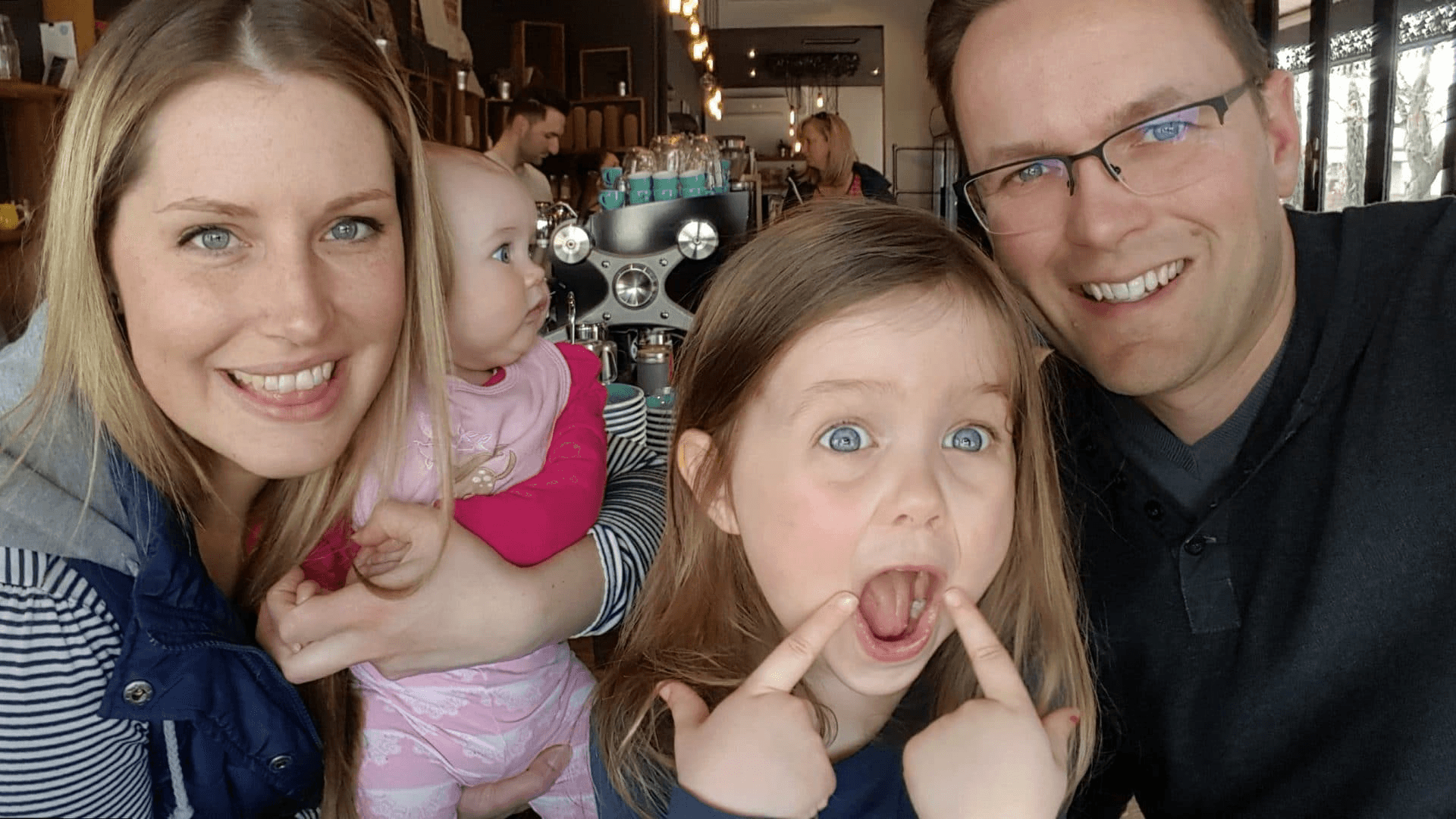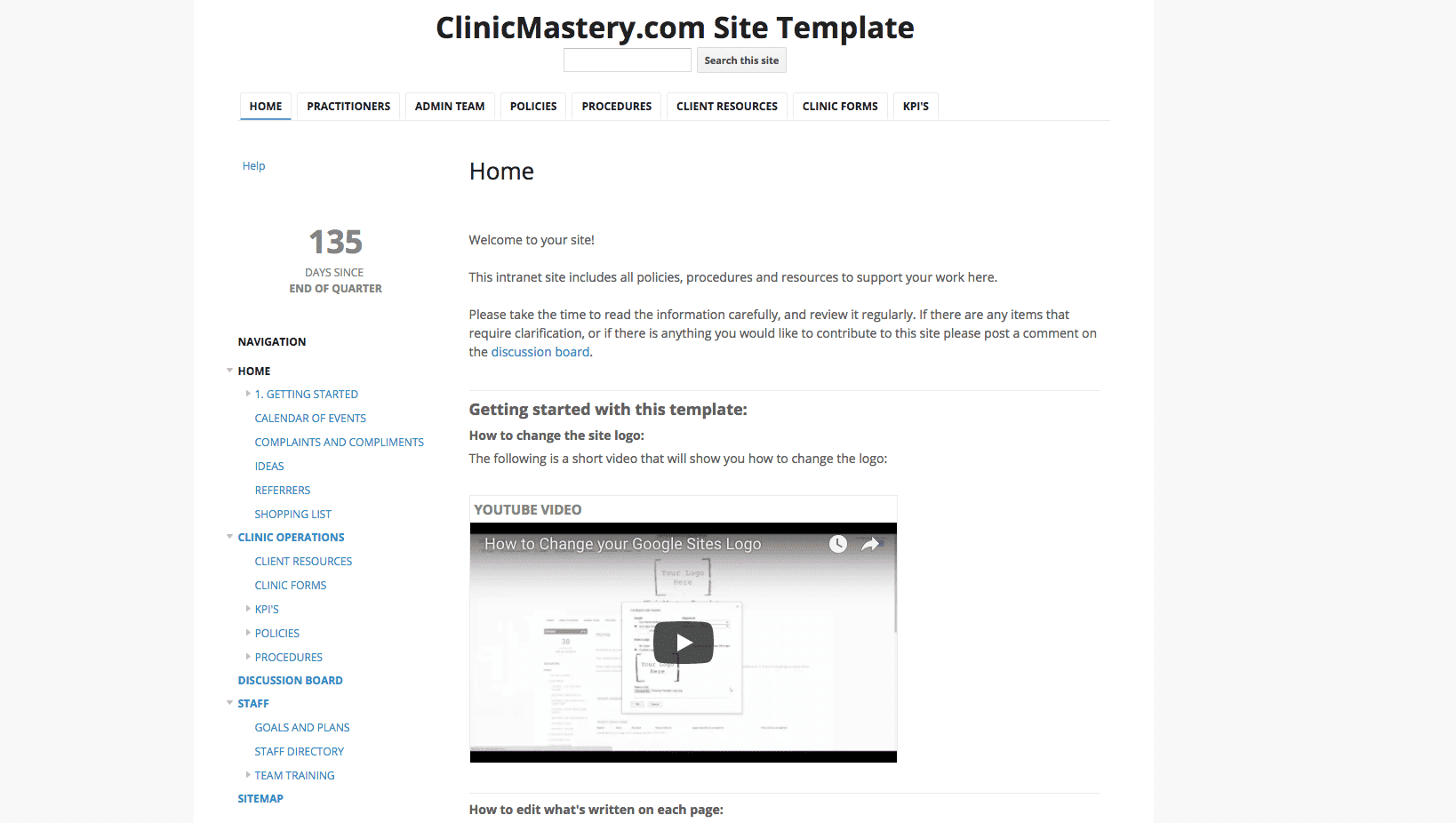Personal Mastery
•
15 min read
•
Nov 18, 2017
Becoming A Clinic Owner: How to Transition From The Main Practitioner To Not Consulting At All
Becoming A Clinic Owner: How To ‘Come Off The Tools’
If you’re time-poor, trying to juggle your role as a clinic owner and as a health professional consulting with patients, you might be wondering how your can reduce your consulting hours so that you can work more on the business, to invest in your team and your client experience.
Im sure you’d agree that there never seems to be enough time to do all the things you want to grow you clinic.
The reality is that you’re are at risk of losing your passion for healthcare and at-risk of burning out. It’s sad, but true!
You need to go from working in the business (consulting), to being able to work on the business (leadership). You need be become the Clinic Owner!

Im not suggesting you need to stop consulting forever… You just need to have the capacity to take care of your team and clients properly.
What i’m suggesting is that you need to reduce the reliance of the clinic’s performance on you by training your team to deliver amazing client experiences.
To do that you need to ‘come off the tools‘ either completely or enough to support the team in being able to treat patients and grow the clinic.
As a health professional ourselves, and as part of the Clinic Mastery Business Academy, we work exclusively with private practice owners to Grow Your Clinic with a variety of outcomes in mind, especially for you, the owner…
In this article I’m going to share with you the 6 step Action Plan to help you ‘come off the tools’ and become a real clinic owner.
The Problem is Time and Structure
It’s likely you became a health professional because you love working with patients, you love helping them live a better life with a better body. It’s why we’re health professionals too!
But, if you become bogged down with a full consulting list or a long list of low-level reception operations, it’s likely your clinic is heavily reliant on you to see patients and ultimately pay the bills.
If it’s like this then you have a job, not a business…
I’m sure you don’t want to be in that position, but if you don’t have the time, systems or structures in place then you’ll be stuck in your ability to retain great practitioners, deliver amazing client experiences and grow your clinic.

The goal as a clinic owner is to allow you to have the choice over your options. Choice over how much you need to work in the clinic, or work on the business.
Given that our core role as a health professional is to see patients, knowing how transition from the main practitioner to not consulting at all (*if that’s what you want) requires us to be very deliberate and considerate in how we go about it.
Step 1: Write Your New Clinic Owner Job Description
The most valuable way to start is to identify exactly what your clinic owner position description will be once you are no longer seeing clients.
You’ll be able to reinforce your outcome, provide your team with clarity as to your role, and also give you motivation to see it through.
Your new clinic owner role will see you take on new responsibilities, but also hand over a number of responsibilities to others.
So, you may also like to create a new organisational structure and look at the position descriptions for other key team members at the same time.

While it can be confronting to list all the tasks you feel you’re not accomplishing to the best of your ability right now, it can be very motivating to see that there will be a time soon when you can focus entirely on working on your business, rather than in it.
Step 2: Nominate your final date for consulting
It’s really important for you to absolutely commit to that date.
Some people have a date in mind that coincides with an upcoming life event such as moving house, taking extended leave, or preparing for an addition to the family.

Others may like to nominate a date that coincides with a calendar event such as the end of Financial Year, or Christmas.
The reason you need to absolutely commit to that date is because over the course of your journey coming off the tools you will be pulled in various directions, and tempted to continue consulting for a number of reasons.
You need to decide that even in the face of major disruption to your business, potential loss of money, clients or even staff, you will not budge on this date.
It will become an anchor of stability amongst rapid change, and motivate you to keep going through tough times.
It doesn’t matter if this date is 3 months, 6 months or 1 year from now, the commitment and the process to get there is the same.
Step 3: Prepare Your Appointment Book
Rule out your diary after this final date
Make it clear to yourself and your team that no one can book an appointment with you after this date.
Gradually reduce available consulting sessions before this date
As a clinic owner you need to create time to develop the systems needed for your business to survive without you, and to engage and motivate your team to be aligned and focused on the outcome of the entire process by systematically removing either half days or full days between now and your final consulting date.
This will have the added benefit of making your appointment availability more scarce, enabling you to manage the transition for some of your clients to start seeing other practitioners in your clinic.

You are now no longer accepting new clients
Your focus is on managing a transition for your clients to see other practitioners in your clinic instead of you.
The easiest clients to transition are those you haven’t yet seen, so make a decision to no longer accept new clients.
Besides, as your availability to your current clients becomes more scarce, your diary will become very full of clinic owner duties very quickly anyway.
Close any waiting lists
If you have a waiting list of clients to see you, don’t add any more clients to it. It’s now closed.
Contact each client on the list already and either book them with a different practitioner, or manage a transition for them by offering to see them for one final appointment so you can introduce them to their new practitioner.
Blank appointments are your best friend
Make sure you don’t try to fill them! This is one of the most confronting mindset challenges to overcome.
As a clinic owner you’ve been used to doing everything you can to maintain a full appointment book.
With gaps in your diary from late cancels or reschedules, you will feel tempted to book people into those times, but you must protect your diary.
If you cannot commit to keeping gaps in your appointment book ruled out, then you need to go back and review your intended outcome for this process and make sure it is sufficiently motivating for you to see it through.
Step 4: Prepare Your Team
Meet with each team member individually
A critical part of this entire process is ensuring your team is aligned with your outcome.

Your team needs to understand why you’re doing this, and you can help them understand by meeting with them individually to discuss your intentions, and vision for your business once you’re no longer consulting.
This is a great way to help nurture those that may be feeling insecure or confused about your reasons for no longer consulting.
Bring your team together
Hold an all-in team meeting to discuss your reasons why you’ve made a decision to come off the tools, and formalise your strategy for your appointment book.
Your team will have lots of questions, and some may still have some concerns about the change.
Make this a meeting that’s different to other meetings – perhaps hold it off site, over dinner or drinks, or connect it with a quarterly strategy meeting.
Tell your story, and be honest. The whole process should invigorate and energise your team.

Aside from the fact they will benefit with more of your attention, they will also find opportunity for more clients as you manage a transition to other practitioners, and more responsibility as you start systemising and delegating your usual tasks to others.
Identify practitioners to whom you will transition your clients
Meet regularly with 2-3 practitioners and use this time to discuss clients you are sending their way, and also to train them specifically on how you treat those clients.
Introduce your clients to them
Even if your clients don’t know about your plan to come off the tools, it’s important for clients to be familiar with other people who are in your clinic.
Talk about the other team members during your appointments, and introduce your clients to other practitioners – even if only in passing.
Encourage those team members to observe as many sessions as possible
This makes it much easier to transition clients over to them. For difficult transitions it’s very valuable to be open and honest in your handover process.
Have the new practitioner sit in on a number of consults with you, and then you can check in on their progress once the new practitioner has taken over.

Be thorough in your clinical notes
Make sure your have all your clinical notes up to date and add useful handover information for the next practitioner.
This will enable a smooth transition and support your team to continue the conversations you last had with those clients.
Reinforce your outcome
Talk about the process, your final date, and where your focus will be after this date. Spend time with your team and reinforce your commitment to them on a weekly basis.
Step 5: Communicate to Clients, Referrers & other Clinic Owners
Tell Your Patients
Take some time during your appointments to tell your clients that you won’t be directly consulting one on one with them anymore.

Here’s an example of how the conversation may go:
“I have come to a decision to step back from my consulting role within the business. The main reason for this is that the business has grown to a level where I feel I need time to invest in our staff more to continue to deliver a high quality service for all the clients that see us. I want everyone who visits our clinic to receive the same level of care that you expect when you see me and I think I will be able to influence more clients positively by doing this.
I am putting you in the capable hands of……… and will ensure they have a thorough handover of your treatment plan and progress. Thank you for your understanding, I’m not going anywhere, I’ll be hard at work ensuring your expectations are not only met but exceeded long into the future.”
Train your reception team
When clients call to book an appointment with you, your reception team need to know what to say. It’s important to be direct, but also conversational.

Respond as you normally would to any enquiry with “How can we help”, or “What have you done”.
Then you can use a phone script such as the following we used at our clinic:
“I’m sorry, Daniel’s books are closed until the end of the year, but he is working very closely with the other superstar podiatrists here to make sure everyone is well looked after… John specialises in that concern so I would recommend you book an appointment with him and Daniel can monitor your progress with John”
We also used the following script for when a new was referred directly to me:
“I’m really sorry Daniel is the director of our clinic, but isn’t consulting with clients anymore. We’ve got other amazing podiatrists that Daniel mentors, can I make an appointment for you with John? Everyone loves him”
Once you’ve written a script that works for you, print it and place near every reception phone / computer so it’s easy to refer to.
Meet with referrers and other people in your professional networks
Arrange a time to talk with people who refer to your clinic about your decision and how you intend to use your time training and mentoring your team to deliver the same high level of service they have come to expect from you.

Step 6: Be present throughout the process
Be present in your clinic! By coming off the tools it doesn’t mean you are no longer there – at least for a period of time. You are still the clinic owner!
Take responsibility for everything that happens in your clinic, and look for solutions in the form of new systems.
Remember you will lose some clients. But that’s okay, and a normal part of the process. As they regain trust in you they can return – especially if you make it easy for them to return.
Some clients may be upset because they’ve been handed over to a different practitioner earlier than others.
If they see you consulting, they may wonder “Why can they can see you and I can’t?” Be ready to acknowledge and nurture those clients and continue to be present in their treatment journey, even if you’re not directly providing the treatment.
Check in with your special clients by phoning them after they’ve seen one of your other practitioners (perhaps after a couple of visits)
Pop in for a quick hello whenever your clients are seeing a different practitioner – just to reinforce that you’re still around.
Overall, with good communication, a solid commitment to the process, and a team supporting the transition you can be confident that the process will have the best chance to go smoothly.
Conclusion
The outcome for becoming a real clinic owner and coming off the tools is highly personal and individual.

For you the aim maybe to remove yourself as the bottleneck and grow your clinic to a level far greater than your would have otherwise. It could be that you simply want to gain freedom from the day to day grind, or build value into their business before selling it.
For others, it may be about taking an extended break, spending more time with family or having space for chasing other opportunities.
Whatever the outcome, the reward is huge, and the key is to have a clear conviction to see it through.
Follow the process carefully, and surround yourself with people who will support you along the way.
We believe, there’s no need to re-invent the wheel! If you think thats a good idea, perhaps you’d be interested to learn more about how we help our members are automating and growing their clinic in our Business Academy…
Until next time, remember to…
Live with Passion, because Everyday is an Opportunity for you to Make Your difference!
Becoming A Clinic Owner: How To ‘Come Off The Tools’
If you’re time-poor, trying to juggle your role as a clinic owner and as a health professional consulting with patients, you might be wondering how your can reduce your consulting hours so that you can work more on the business, to invest in your team and your client experience.
Im sure you’d agree that there never seems to be enough time to do all the things you want to grow you clinic.
The reality is that you’re are at risk of losing your passion for healthcare and at-risk of burning out. It’s sad, but true!
You need to go from working in the business (consulting), to being able to work on the business (leadership). You need be become the Clinic Owner!

Im not suggesting you need to stop consulting forever… You just need to have the capacity to take care of your team and clients properly.
What i’m suggesting is that you need to reduce the reliance of the clinic’s performance on you by training your team to deliver amazing client experiences.
To do that you need to ‘come off the tools‘ either completely or enough to support the team in being able to treat patients and grow the clinic.
As a health professional ourselves, and as part of the Clinic Mastery Business Academy, we work exclusively with private practice owners to Grow Your Clinic with a variety of outcomes in mind, especially for you, the owner…
In this article I’m going to share with you the 6 step Action Plan to help you ‘come off the tools’ and become a real clinic owner.
The Problem is Time and Structure
It’s likely you became a health professional because you love working with patients, you love helping them live a better life with a better body. It’s why we’re health professionals too!
But, if you become bogged down with a full consulting list or a long list of low-level reception operations, it’s likely your clinic is heavily reliant on you to see patients and ultimately pay the bills.
If it’s like this then you have a job, not a business…
I’m sure you don’t want to be in that position, but if you don’t have the time, systems or structures in place then you’ll be stuck in your ability to retain great practitioners, deliver amazing client experiences and grow your clinic.

The goal as a clinic owner is to allow you to have the choice over your options. Choice over how much you need to work in the clinic, or work on the business.
Given that our core role as a health professional is to see patients, knowing how transition from the main practitioner to not consulting at all (*if that’s what you want) requires us to be very deliberate and considerate in how we go about it.
Step 1: Write Your New Clinic Owner Job Description
The most valuable way to start is to identify exactly what your clinic owner position description will be once you are no longer seeing clients.
You’ll be able to reinforce your outcome, provide your team with clarity as to your role, and also give you motivation to see it through.
Your new clinic owner role will see you take on new responsibilities, but also hand over a number of responsibilities to others.
So, you may also like to create a new organisational structure and look at the position descriptions for other key team members at the same time.

While it can be confronting to list all the tasks you feel you’re not accomplishing to the best of your ability right now, it can be very motivating to see that there will be a time soon when you can focus entirely on working on your business, rather than in it.
Step 2: Nominate your final date for consulting
It’s really important for you to absolutely commit to that date.
Some people have a date in mind that coincides with an upcoming life event such as moving house, taking extended leave, or preparing for an addition to the family.

Others may like to nominate a date that coincides with a calendar event such as the end of Financial Year, or Christmas.
The reason you need to absolutely commit to that date is because over the course of your journey coming off the tools you will be pulled in various directions, and tempted to continue consulting for a number of reasons.
You need to decide that even in the face of major disruption to your business, potential loss of money, clients or even staff, you will not budge on this date.
It will become an anchor of stability amongst rapid change, and motivate you to keep going through tough times.
It doesn’t matter if this date is 3 months, 6 months or 1 year from now, the commitment and the process to get there is the same.
Step 3: Prepare Your Appointment Book
Rule out your diary after this final date
Make it clear to yourself and your team that no one can book an appointment with you after this date.
Gradually reduce available consulting sessions before this date
As a clinic owner you need to create time to develop the systems needed for your business to survive without you, and to engage and motivate your team to be aligned and focused on the outcome of the entire process by systematically removing either half days or full days between now and your final consulting date.
This will have the added benefit of making your appointment availability more scarce, enabling you to manage the transition for some of your clients to start seeing other practitioners in your clinic.

You are now no longer accepting new clients
Your focus is on managing a transition for your clients to see other practitioners in your clinic instead of you.
The easiest clients to transition are those you haven’t yet seen, so make a decision to no longer accept new clients.
Besides, as your availability to your current clients becomes more scarce, your diary will become very full of clinic owner duties very quickly anyway.
Close any waiting lists
If you have a waiting list of clients to see you, don’t add any more clients to it. It’s now closed.
Contact each client on the list already and either book them with a different practitioner, or manage a transition for them by offering to see them for one final appointment so you can introduce them to their new practitioner.
Blank appointments are your best friend
Make sure you don’t try to fill them! This is one of the most confronting mindset challenges to overcome.
As a clinic owner you’ve been used to doing everything you can to maintain a full appointment book.
With gaps in your diary from late cancels or reschedules, you will feel tempted to book people into those times, but you must protect your diary.
If you cannot commit to keeping gaps in your appointment book ruled out, then you need to go back and review your intended outcome for this process and make sure it is sufficiently motivating for you to see it through.
Step 4: Prepare Your Team
Meet with each team member individually
A critical part of this entire process is ensuring your team is aligned with your outcome.

Your team needs to understand why you’re doing this, and you can help them understand by meeting with them individually to discuss your intentions, and vision for your business once you’re no longer consulting.
This is a great way to help nurture those that may be feeling insecure or confused about your reasons for no longer consulting.
Bring your team together
Hold an all-in team meeting to discuss your reasons why you’ve made a decision to come off the tools, and formalise your strategy for your appointment book.
Your team will have lots of questions, and some may still have some concerns about the change.
Make this a meeting that’s different to other meetings – perhaps hold it off site, over dinner or drinks, or connect it with a quarterly strategy meeting.
Tell your story, and be honest. The whole process should invigorate and energise your team.

Aside from the fact they will benefit with more of your attention, they will also find opportunity for more clients as you manage a transition to other practitioners, and more responsibility as you start systemising and delegating your usual tasks to others.
Identify practitioners to whom you will transition your clients
Meet regularly with 2-3 practitioners and use this time to discuss clients you are sending their way, and also to train them specifically on how you treat those clients.
Introduce your clients to them
Even if your clients don’t know about your plan to come off the tools, it’s important for clients to be familiar with other people who are in your clinic.
Talk about the other team members during your appointments, and introduce your clients to other practitioners – even if only in passing.
Encourage those team members to observe as many sessions as possible
This makes it much easier to transition clients over to them. For difficult transitions it’s very valuable to be open and honest in your handover process.
Have the new practitioner sit in on a number of consults with you, and then you can check in on their progress once the new practitioner has taken over.

Be thorough in your clinical notes
Make sure your have all your clinical notes up to date and add useful handover information for the next practitioner.
This will enable a smooth transition and support your team to continue the conversations you last had with those clients.
Reinforce your outcome
Talk about the process, your final date, and where your focus will be after this date. Spend time with your team and reinforce your commitment to them on a weekly basis.
Step 5: Communicate to Clients, Referrers & other Clinic Owners
Tell Your Patients
Take some time during your appointments to tell your clients that you won’t be directly consulting one on one with them anymore.

Here’s an example of how the conversation may go:
“I have come to a decision to step back from my consulting role within the business. The main reason for this is that the business has grown to a level where I feel I need time to invest in our staff more to continue to deliver a high quality service for all the clients that see us. I want everyone who visits our clinic to receive the same level of care that you expect when you see me and I think I will be able to influence more clients positively by doing this.
I am putting you in the capable hands of……… and will ensure they have a thorough handover of your treatment plan and progress. Thank you for your understanding, I’m not going anywhere, I’ll be hard at work ensuring your expectations are not only met but exceeded long into the future.”
Train your reception team
When clients call to book an appointment with you, your reception team need to know what to say. It’s important to be direct, but also conversational.

Respond as you normally would to any enquiry with “How can we help”, or “What have you done”.
Then you can use a phone script such as the following we used at our clinic:
“I’m sorry, Daniel’s books are closed until the end of the year, but he is working very closely with the other superstar podiatrists here to make sure everyone is well looked after… John specialises in that concern so I would recommend you book an appointment with him and Daniel can monitor your progress with John”
We also used the following script for when a new was referred directly to me:
“I’m really sorry Daniel is the director of our clinic, but isn’t consulting with clients anymore. We’ve got other amazing podiatrists that Daniel mentors, can I make an appointment for you with John? Everyone loves him”
Once you’ve written a script that works for you, print it and place near every reception phone / computer so it’s easy to refer to.
Meet with referrers and other people in your professional networks
Arrange a time to talk with people who refer to your clinic about your decision and how you intend to use your time training and mentoring your team to deliver the same high level of service they have come to expect from you.

Step 6: Be present throughout the process
Be present in your clinic! By coming off the tools it doesn’t mean you are no longer there – at least for a period of time. You are still the clinic owner!
Take responsibility for everything that happens in your clinic, and look for solutions in the form of new systems.
Remember you will lose some clients. But that’s okay, and a normal part of the process. As they regain trust in you they can return – especially if you make it easy for them to return.
Some clients may be upset because they’ve been handed over to a different practitioner earlier than others.
If they see you consulting, they may wonder “Why can they can see you and I can’t?” Be ready to acknowledge and nurture those clients and continue to be present in their treatment journey, even if you’re not directly providing the treatment.
Check in with your special clients by phoning them after they’ve seen one of your other practitioners (perhaps after a couple of visits)
Pop in for a quick hello whenever your clients are seeing a different practitioner – just to reinforce that you’re still around.
Overall, with good communication, a solid commitment to the process, and a team supporting the transition you can be confident that the process will have the best chance to go smoothly.
Conclusion
The outcome for becoming a real clinic owner and coming off the tools is highly personal and individual.

For you the aim maybe to remove yourself as the bottleneck and grow your clinic to a level far greater than your would have otherwise. It could be that you simply want to gain freedom from the day to day grind, or build value into their business before selling it.
For others, it may be about taking an extended break, spending more time with family or having space for chasing other opportunities.
Whatever the outcome, the reward is huge, and the key is to have a clear conviction to see it through.
Follow the process carefully, and surround yourself with people who will support you along the way.
We believe, there’s no need to re-invent the wheel! If you think thats a good idea, perhaps you’d be interested to learn more about how we help our members are automating and growing their clinic in our Business Academy…
Until next time, remember to…
Live with Passion, because Everyday is an Opportunity for you to Make Your difference!
Becoming A Clinic Owner: How To ‘Come Off The Tools’
If you’re time-poor, trying to juggle your role as a clinic owner and as a health professional consulting with patients, you might be wondering how your can reduce your consulting hours so that you can work more on the business, to invest in your team and your client experience.
Im sure you’d agree that there never seems to be enough time to do all the things you want to grow you clinic.
The reality is that you’re are at risk of losing your passion for healthcare and at-risk of burning out. It’s sad, but true!
You need to go from working in the business (consulting), to being able to work on the business (leadership). You need be become the Clinic Owner!

Im not suggesting you need to stop consulting forever… You just need to have the capacity to take care of your team and clients properly.
What i’m suggesting is that you need to reduce the reliance of the clinic’s performance on you by training your team to deliver amazing client experiences.
To do that you need to ‘come off the tools‘ either completely or enough to support the team in being able to treat patients and grow the clinic.
As a health professional ourselves, and as part of the Clinic Mastery Business Academy, we work exclusively with private practice owners to Grow Your Clinic with a variety of outcomes in mind, especially for you, the owner…
In this article I’m going to share with you the 6 step Action Plan to help you ‘come off the tools’ and become a real clinic owner.
The Problem is Time and Structure
It’s likely you became a health professional because you love working with patients, you love helping them live a better life with a better body. It’s why we’re health professionals too!
But, if you become bogged down with a full consulting list or a long list of low-level reception operations, it’s likely your clinic is heavily reliant on you to see patients and ultimately pay the bills.
If it’s like this then you have a job, not a business…
I’m sure you don’t want to be in that position, but if you don’t have the time, systems or structures in place then you’ll be stuck in your ability to retain great practitioners, deliver amazing client experiences and grow your clinic.

The goal as a clinic owner is to allow you to have the choice over your options. Choice over how much you need to work in the clinic, or work on the business.
Given that our core role as a health professional is to see patients, knowing how transition from the main practitioner to not consulting at all (*if that’s what you want) requires us to be very deliberate and considerate in how we go about it.
Step 1: Write Your New Clinic Owner Job Description
The most valuable way to start is to identify exactly what your clinic owner position description will be once you are no longer seeing clients.
You’ll be able to reinforce your outcome, provide your team with clarity as to your role, and also give you motivation to see it through.
Your new clinic owner role will see you take on new responsibilities, but also hand over a number of responsibilities to others.
So, you may also like to create a new organisational structure and look at the position descriptions for other key team members at the same time.

While it can be confronting to list all the tasks you feel you’re not accomplishing to the best of your ability right now, it can be very motivating to see that there will be a time soon when you can focus entirely on working on your business, rather than in it.
Step 2: Nominate your final date for consulting
It’s really important for you to absolutely commit to that date.
Some people have a date in mind that coincides with an upcoming life event such as moving house, taking extended leave, or preparing for an addition to the family.

Others may like to nominate a date that coincides with a calendar event such as the end of Financial Year, or Christmas.
The reason you need to absolutely commit to that date is because over the course of your journey coming off the tools you will be pulled in various directions, and tempted to continue consulting for a number of reasons.
You need to decide that even in the face of major disruption to your business, potential loss of money, clients or even staff, you will not budge on this date.
It will become an anchor of stability amongst rapid change, and motivate you to keep going through tough times.
It doesn’t matter if this date is 3 months, 6 months or 1 year from now, the commitment and the process to get there is the same.
Step 3: Prepare Your Appointment Book
Rule out your diary after this final date
Make it clear to yourself and your team that no one can book an appointment with you after this date.
Gradually reduce available consulting sessions before this date
As a clinic owner you need to create time to develop the systems needed for your business to survive without you, and to engage and motivate your team to be aligned and focused on the outcome of the entire process by systematically removing either half days or full days between now and your final consulting date.
This will have the added benefit of making your appointment availability more scarce, enabling you to manage the transition for some of your clients to start seeing other practitioners in your clinic.

You are now no longer accepting new clients
Your focus is on managing a transition for your clients to see other practitioners in your clinic instead of you.
The easiest clients to transition are those you haven’t yet seen, so make a decision to no longer accept new clients.
Besides, as your availability to your current clients becomes more scarce, your diary will become very full of clinic owner duties very quickly anyway.
Close any waiting lists
If you have a waiting list of clients to see you, don’t add any more clients to it. It’s now closed.
Contact each client on the list already and either book them with a different practitioner, or manage a transition for them by offering to see them for one final appointment so you can introduce them to their new practitioner.
Blank appointments are your best friend
Make sure you don’t try to fill them! This is one of the most confronting mindset challenges to overcome.
As a clinic owner you’ve been used to doing everything you can to maintain a full appointment book.
With gaps in your diary from late cancels or reschedules, you will feel tempted to book people into those times, but you must protect your diary.
If you cannot commit to keeping gaps in your appointment book ruled out, then you need to go back and review your intended outcome for this process and make sure it is sufficiently motivating for you to see it through.
Step 4: Prepare Your Team
Meet with each team member individually
A critical part of this entire process is ensuring your team is aligned with your outcome.

Your team needs to understand why you’re doing this, and you can help them understand by meeting with them individually to discuss your intentions, and vision for your business once you’re no longer consulting.
This is a great way to help nurture those that may be feeling insecure or confused about your reasons for no longer consulting.
Bring your team together
Hold an all-in team meeting to discuss your reasons why you’ve made a decision to come off the tools, and formalise your strategy for your appointment book.
Your team will have lots of questions, and some may still have some concerns about the change.
Make this a meeting that’s different to other meetings – perhaps hold it off site, over dinner or drinks, or connect it with a quarterly strategy meeting.
Tell your story, and be honest. The whole process should invigorate and energise your team.

Aside from the fact they will benefit with more of your attention, they will also find opportunity for more clients as you manage a transition to other practitioners, and more responsibility as you start systemising and delegating your usual tasks to others.
Identify practitioners to whom you will transition your clients
Meet regularly with 2-3 practitioners and use this time to discuss clients you are sending their way, and also to train them specifically on how you treat those clients.
Introduce your clients to them
Even if your clients don’t know about your plan to come off the tools, it’s important for clients to be familiar with other people who are in your clinic.
Talk about the other team members during your appointments, and introduce your clients to other practitioners – even if only in passing.
Encourage those team members to observe as many sessions as possible
This makes it much easier to transition clients over to them. For difficult transitions it’s very valuable to be open and honest in your handover process.
Have the new practitioner sit in on a number of consults with you, and then you can check in on their progress once the new practitioner has taken over.

Be thorough in your clinical notes
Make sure your have all your clinical notes up to date and add useful handover information for the next practitioner.
This will enable a smooth transition and support your team to continue the conversations you last had with those clients.
Reinforce your outcome
Talk about the process, your final date, and where your focus will be after this date. Spend time with your team and reinforce your commitment to them on a weekly basis.
Step 5: Communicate to Clients, Referrers & other Clinic Owners
Tell Your Patients
Take some time during your appointments to tell your clients that you won’t be directly consulting one on one with them anymore.

Here’s an example of how the conversation may go:
“I have come to a decision to step back from my consulting role within the business. The main reason for this is that the business has grown to a level where I feel I need time to invest in our staff more to continue to deliver a high quality service for all the clients that see us. I want everyone who visits our clinic to receive the same level of care that you expect when you see me and I think I will be able to influence more clients positively by doing this.
I am putting you in the capable hands of……… and will ensure they have a thorough handover of your treatment plan and progress. Thank you for your understanding, I’m not going anywhere, I’ll be hard at work ensuring your expectations are not only met but exceeded long into the future.”
Train your reception team
When clients call to book an appointment with you, your reception team need to know what to say. It’s important to be direct, but also conversational.

Respond as you normally would to any enquiry with “How can we help”, or “What have you done”.
Then you can use a phone script such as the following we used at our clinic:
“I’m sorry, Daniel’s books are closed until the end of the year, but he is working very closely with the other superstar podiatrists here to make sure everyone is well looked after… John specialises in that concern so I would recommend you book an appointment with him and Daniel can monitor your progress with John”
We also used the following script for when a new was referred directly to me:
“I’m really sorry Daniel is the director of our clinic, but isn’t consulting with clients anymore. We’ve got other amazing podiatrists that Daniel mentors, can I make an appointment for you with John? Everyone loves him”
Once you’ve written a script that works for you, print it and place near every reception phone / computer so it’s easy to refer to.
Meet with referrers and other people in your professional networks
Arrange a time to talk with people who refer to your clinic about your decision and how you intend to use your time training and mentoring your team to deliver the same high level of service they have come to expect from you.

Step 6: Be present throughout the process
Be present in your clinic! By coming off the tools it doesn’t mean you are no longer there – at least for a period of time. You are still the clinic owner!
Take responsibility for everything that happens in your clinic, and look for solutions in the form of new systems.
Remember you will lose some clients. But that’s okay, and a normal part of the process. As they regain trust in you they can return – especially if you make it easy for them to return.
Some clients may be upset because they’ve been handed over to a different practitioner earlier than others.
If they see you consulting, they may wonder “Why can they can see you and I can’t?” Be ready to acknowledge and nurture those clients and continue to be present in their treatment journey, even if you’re not directly providing the treatment.
Check in with your special clients by phoning them after they’ve seen one of your other practitioners (perhaps after a couple of visits)
Pop in for a quick hello whenever your clients are seeing a different practitioner – just to reinforce that you’re still around.
Overall, with good communication, a solid commitment to the process, and a team supporting the transition you can be confident that the process will have the best chance to go smoothly.
Conclusion
The outcome for becoming a real clinic owner and coming off the tools is highly personal and individual.

For you the aim maybe to remove yourself as the bottleneck and grow your clinic to a level far greater than your would have otherwise. It could be that you simply want to gain freedom from the day to day grind, or build value into their business before selling it.
For others, it may be about taking an extended break, spending more time with family or having space for chasing other opportunities.
Whatever the outcome, the reward is huge, and the key is to have a clear conviction to see it through.
Follow the process carefully, and surround yourself with people who will support you along the way.
We believe, there’s no need to re-invent the wheel! If you think thats a good idea, perhaps you’d be interested to learn more about how we help our members are automating and growing their clinic in our Business Academy…
Until next time, remember to…
Live with Passion, because Everyday is an Opportunity for you to Make Your difference!
Becoming A Clinic Owner: How To ‘Come Off The Tools’
If you’re time-poor, trying to juggle your role as a clinic owner and as a health professional consulting with patients, you might be wondering how your can reduce your consulting hours so that you can work more on the business, to invest in your team and your client experience.
Im sure you’d agree that there never seems to be enough time to do all the things you want to grow you clinic.
The reality is that you’re are at risk of losing your passion for healthcare and at-risk of burning out. It’s sad, but true!
You need to go from working in the business (consulting), to being able to work on the business (leadership). You need be become the Clinic Owner!

Im not suggesting you need to stop consulting forever… You just need to have the capacity to take care of your team and clients properly.
What i’m suggesting is that you need to reduce the reliance of the clinic’s performance on you by training your team to deliver amazing client experiences.
To do that you need to ‘come off the tools‘ either completely or enough to support the team in being able to treat patients and grow the clinic.
As a health professional ourselves, and as part of the Clinic Mastery Business Academy, we work exclusively with private practice owners to Grow Your Clinic with a variety of outcomes in mind, especially for you, the owner…
In this article I’m going to share with you the 6 step Action Plan to help you ‘come off the tools’ and become a real clinic owner.
The Problem is Time and Structure
It’s likely you became a health professional because you love working with patients, you love helping them live a better life with a better body. It’s why we’re health professionals too!
But, if you become bogged down with a full consulting list or a long list of low-level reception operations, it’s likely your clinic is heavily reliant on you to see patients and ultimately pay the bills.
If it’s like this then you have a job, not a business…
I’m sure you don’t want to be in that position, but if you don’t have the time, systems or structures in place then you’ll be stuck in your ability to retain great practitioners, deliver amazing client experiences and grow your clinic.

The goal as a clinic owner is to allow you to have the choice over your options. Choice over how much you need to work in the clinic, or work on the business.
Given that our core role as a health professional is to see patients, knowing how transition from the main practitioner to not consulting at all (*if that’s what you want) requires us to be very deliberate and considerate in how we go about it.
Step 1: Write Your New Clinic Owner Job Description
The most valuable way to start is to identify exactly what your clinic owner position description will be once you are no longer seeing clients.
You’ll be able to reinforce your outcome, provide your team with clarity as to your role, and also give you motivation to see it through.
Your new clinic owner role will see you take on new responsibilities, but also hand over a number of responsibilities to others.
So, you may also like to create a new organisational structure and look at the position descriptions for other key team members at the same time.

While it can be confronting to list all the tasks you feel you’re not accomplishing to the best of your ability right now, it can be very motivating to see that there will be a time soon when you can focus entirely on working on your business, rather than in it.
Step 2: Nominate your final date for consulting
It’s really important for you to absolutely commit to that date.
Some people have a date in mind that coincides with an upcoming life event such as moving house, taking extended leave, or preparing for an addition to the family.

Others may like to nominate a date that coincides with a calendar event such as the end of Financial Year, or Christmas.
The reason you need to absolutely commit to that date is because over the course of your journey coming off the tools you will be pulled in various directions, and tempted to continue consulting for a number of reasons.
You need to decide that even in the face of major disruption to your business, potential loss of money, clients or even staff, you will not budge on this date.
It will become an anchor of stability amongst rapid change, and motivate you to keep going through tough times.
It doesn’t matter if this date is 3 months, 6 months or 1 year from now, the commitment and the process to get there is the same.
Step 3: Prepare Your Appointment Book
Rule out your diary after this final date
Make it clear to yourself and your team that no one can book an appointment with you after this date.
Gradually reduce available consulting sessions before this date
As a clinic owner you need to create time to develop the systems needed for your business to survive without you, and to engage and motivate your team to be aligned and focused on the outcome of the entire process by systematically removing either half days or full days between now and your final consulting date.
This will have the added benefit of making your appointment availability more scarce, enabling you to manage the transition for some of your clients to start seeing other practitioners in your clinic.

You are now no longer accepting new clients
Your focus is on managing a transition for your clients to see other practitioners in your clinic instead of you.
The easiest clients to transition are those you haven’t yet seen, so make a decision to no longer accept new clients.
Besides, as your availability to your current clients becomes more scarce, your diary will become very full of clinic owner duties very quickly anyway.
Close any waiting lists
If you have a waiting list of clients to see you, don’t add any more clients to it. It’s now closed.
Contact each client on the list already and either book them with a different practitioner, or manage a transition for them by offering to see them for one final appointment so you can introduce them to their new practitioner.
Blank appointments are your best friend
Make sure you don’t try to fill them! This is one of the most confronting mindset challenges to overcome.
As a clinic owner you’ve been used to doing everything you can to maintain a full appointment book.
With gaps in your diary from late cancels or reschedules, you will feel tempted to book people into those times, but you must protect your diary.
If you cannot commit to keeping gaps in your appointment book ruled out, then you need to go back and review your intended outcome for this process and make sure it is sufficiently motivating for you to see it through.
Step 4: Prepare Your Team
Meet with each team member individually
A critical part of this entire process is ensuring your team is aligned with your outcome.

Your team needs to understand why you’re doing this, and you can help them understand by meeting with them individually to discuss your intentions, and vision for your business once you’re no longer consulting.
This is a great way to help nurture those that may be feeling insecure or confused about your reasons for no longer consulting.
Bring your team together
Hold an all-in team meeting to discuss your reasons why you’ve made a decision to come off the tools, and formalise your strategy for your appointment book.
Your team will have lots of questions, and some may still have some concerns about the change.
Make this a meeting that’s different to other meetings – perhaps hold it off site, over dinner or drinks, or connect it with a quarterly strategy meeting.
Tell your story, and be honest. The whole process should invigorate and energise your team.

Aside from the fact they will benefit with more of your attention, they will also find opportunity for more clients as you manage a transition to other practitioners, and more responsibility as you start systemising and delegating your usual tasks to others.
Identify practitioners to whom you will transition your clients
Meet regularly with 2-3 practitioners and use this time to discuss clients you are sending their way, and also to train them specifically on how you treat those clients.
Introduce your clients to them
Even if your clients don’t know about your plan to come off the tools, it’s important for clients to be familiar with other people who are in your clinic.
Talk about the other team members during your appointments, and introduce your clients to other practitioners – even if only in passing.
Encourage those team members to observe as many sessions as possible
This makes it much easier to transition clients over to them. For difficult transitions it’s very valuable to be open and honest in your handover process.
Have the new practitioner sit in on a number of consults with you, and then you can check in on their progress once the new practitioner has taken over.

Be thorough in your clinical notes
Make sure your have all your clinical notes up to date and add useful handover information for the next practitioner.
This will enable a smooth transition and support your team to continue the conversations you last had with those clients.
Reinforce your outcome
Talk about the process, your final date, and where your focus will be after this date. Spend time with your team and reinforce your commitment to them on a weekly basis.
Step 5: Communicate to Clients, Referrers & other Clinic Owners
Tell Your Patients
Take some time during your appointments to tell your clients that you won’t be directly consulting one on one with them anymore.

Here’s an example of how the conversation may go:
“I have come to a decision to step back from my consulting role within the business. The main reason for this is that the business has grown to a level where I feel I need time to invest in our staff more to continue to deliver a high quality service for all the clients that see us. I want everyone who visits our clinic to receive the same level of care that you expect when you see me and I think I will be able to influence more clients positively by doing this.
I am putting you in the capable hands of……… and will ensure they have a thorough handover of your treatment plan and progress. Thank you for your understanding, I’m not going anywhere, I’ll be hard at work ensuring your expectations are not only met but exceeded long into the future.”
Train your reception team
When clients call to book an appointment with you, your reception team need to know what to say. It’s important to be direct, but also conversational.

Respond as you normally would to any enquiry with “How can we help”, or “What have you done”.
Then you can use a phone script such as the following we used at our clinic:
“I’m sorry, Daniel’s books are closed until the end of the year, but he is working very closely with the other superstar podiatrists here to make sure everyone is well looked after… John specialises in that concern so I would recommend you book an appointment with him and Daniel can monitor your progress with John”
We also used the following script for when a new was referred directly to me:
“I’m really sorry Daniel is the director of our clinic, but isn’t consulting with clients anymore. We’ve got other amazing podiatrists that Daniel mentors, can I make an appointment for you with John? Everyone loves him”
Once you’ve written a script that works for you, print it and place near every reception phone / computer so it’s easy to refer to.
Meet with referrers and other people in your professional networks
Arrange a time to talk with people who refer to your clinic about your decision and how you intend to use your time training and mentoring your team to deliver the same high level of service they have come to expect from you.

Step 6: Be present throughout the process
Be present in your clinic! By coming off the tools it doesn’t mean you are no longer there – at least for a period of time. You are still the clinic owner!
Take responsibility for everything that happens in your clinic, and look for solutions in the form of new systems.
Remember you will lose some clients. But that’s okay, and a normal part of the process. As they regain trust in you they can return – especially if you make it easy for them to return.
Some clients may be upset because they’ve been handed over to a different practitioner earlier than others.
If they see you consulting, they may wonder “Why can they can see you and I can’t?” Be ready to acknowledge and nurture those clients and continue to be present in their treatment journey, even if you’re not directly providing the treatment.
Check in with your special clients by phoning them after they’ve seen one of your other practitioners (perhaps after a couple of visits)
Pop in for a quick hello whenever your clients are seeing a different practitioner – just to reinforce that you’re still around.
Overall, with good communication, a solid commitment to the process, and a team supporting the transition you can be confident that the process will have the best chance to go smoothly.
Conclusion
The outcome for becoming a real clinic owner and coming off the tools is highly personal and individual.

For you the aim maybe to remove yourself as the bottleneck and grow your clinic to a level far greater than your would have otherwise. It could be that you simply want to gain freedom from the day to day grind, or build value into their business before selling it.
For others, it may be about taking an extended break, spending more time with family or having space for chasing other opportunities.
Whatever the outcome, the reward is huge, and the key is to have a clear conviction to see it through.
Follow the process carefully, and surround yourself with people who will support you along the way.
We believe, there’s no need to re-invent the wheel! If you think thats a good idea, perhaps you’d be interested to learn more about how we help our members are automating and growing their clinic in our Business Academy…
Until next time, remember to…
Live with Passion, because Everyday is an Opportunity for you to Make Your difference!




Article by
Daniel Gibbs
After winning the Telstra Business Award I started getting phone calls from other clinic owners who wanted help, and that’s how Clinic Mastery was born.
How Does Your Clinic Score?
Discover your Clinic Score & Amplify your Impact with Clinics Mastery’s Assess Your Clinic™ Scorecard. Get a rating for the 7 Degrees of Business that you need to master.
Assess Your Clinic
How Does Your Clinic Score?
Discover your Clinic Score & Amplify your Impact with Clinics Mastery’s Assess Your Clinic™ Scorecard. Get a rating for the 7 Degrees of Business that you need to master.
Assess Your Clinic
How Does Your Clinic Score?
Discover your Clinic Score & Amplify your Impact with Clinics Mastery’s Assess Your Clinic™ Scorecard. Get a rating for the 7 Degrees of Business that you need to master.
Assess Your Clinic
Latest
From the Blog
Latest
From the Blog
Latest







